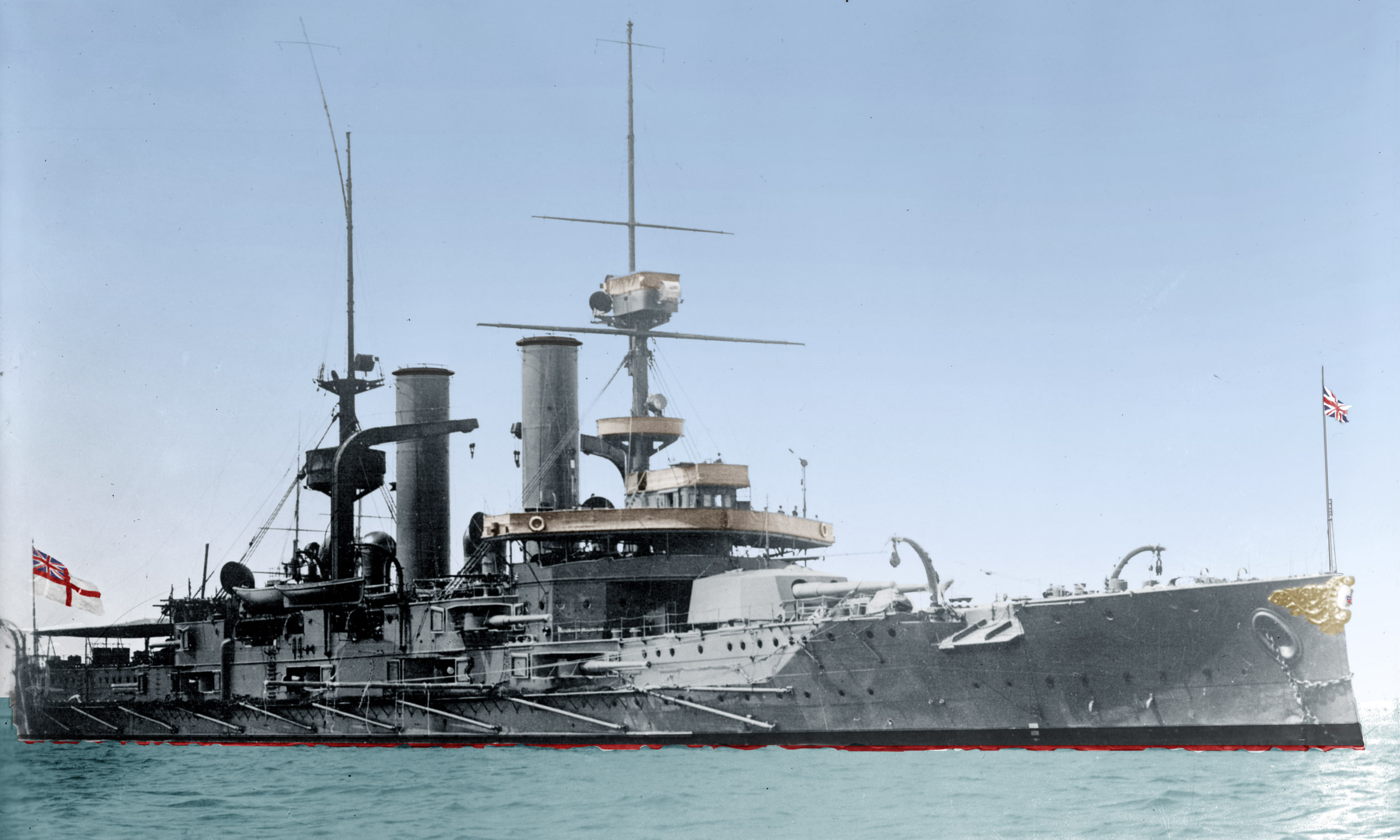
 HMS Swiftsure, Triumph (1904-1922):
HMS Swiftsure, Triumph (1904-1922): WW1 RN Battleships
HMS Dreadnought | Bellerophon class | St. Vincent class | HMS Neptune | Colossus class | Orion class | King George V | Iron Duke class | HMS Agincourt | HMS Erin | HMS Canada | Queen Elizabeth class | Revenge class | G3 classMajestic class | Centurion class | Canopus class | Formidable class | London class | Duncan class | King Edward VII class | Swiftsure class | Lord Nelson class
Invincible class | Indefatigable class | Lion class | HMS Tiger | Courageous class | Renown class | Admiral class | N3 class
The only 2nd class Battleships of the RN in WWI
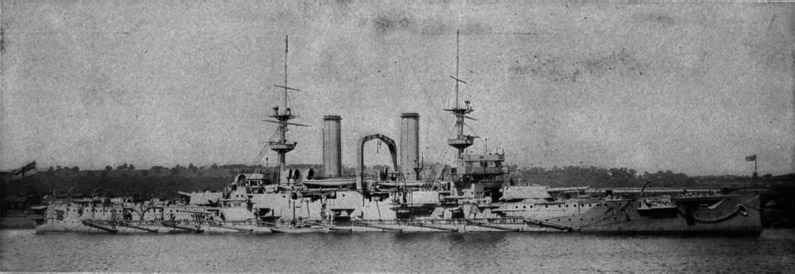
The Swiftsure class were British pre-dreadnought originally ordered by Chile as the Constitución class during a naval arms race to counter’s Argentina own recent acquisitions, two armoured cruisers ordered in Italy (Garibaldi class). They were tailored-designed specifically for this role, to hunt them down. Design-wise, they were smaller, narrower, faster, more lightly armed and protected than the British standard of the time. Their story is furiously similar to the previous Centurion class and HMS Renown, this time ordered by the RN to counter the Russian far east heavy cruisers during the Anglo-Russian naval arm’s race. This was the common origin of the only second class battleships of the RN and they were the only ones seeing actual combat.
In 1902 though, international politics came into the way, and both vessels were repurchased while in construction by the United Kingdom prior to their launch, to prevent their re-purchase by the Russian Empire, then engaged in a contest with the Japanese Empire, an ally, which repurchased the two former cancelled Argentine cruisers in a strange but logical twist of fate. They were completed eventually in 1905 as HMS Swiftsure and Triumph and assigned to the Home Fleet, Channel Fleets, then Mediterranean Fleet, separated in 1913, between the East Indies Station and China Station.
⚙ The naval Arms Race | |
 Armada de Argentina Armada de Argentina |  Armada de Chile Armada de Chile |
| Libertad class (BB) 1887 Veinticinco de Mayo (PC) 1890 Nueve de Julio (PC) 1891 Buenos Aires (PC) 1894 Garibaldi (AC) 1895 San Martín (AC) 1896 Pueyrredón (AC) 1897 General Belgrano (AC) 1898 Rivadavia, Moreno* (AC) 1901 |
Capitán Prat (BB*) 1887 Presidente Errázuriz (PC) 1887 Presidente Pinto (PC) 1887 Blanco Encalada (PC) 1892 Esmeralda (AC) 1894 Ministro Zenteno (PC) 1894 O'Higgins (AC) 1896 Constitución class (BB) 1901 Chacabuco (PC) 1901 |
HMS Swiftsure defended the Canal from Ottoman attacks and took part in the Dardanelles Campaign, shelling Ottoman fortifications. HMS Triumph on her side chased off Graf von Spee’s German East Asia Squadron and shelled the German colony at Tsingtao before being transfered to the Mediterranean to join the fray in the Dardanelles, to be torpedoed and sunk off Gaba Tepe by U-21 on 25 May 1915. Her sister, after Atlantic convoy escort duties was decomm. in April 1917 to free crews for the ASW fleet, and by 1918, disarmed and ended as blockship for the planned second raid on Ostend which never took place, instead sold for BU 1920.
Context of the order and requisition
The Chilean-Argentine Naval arms Race
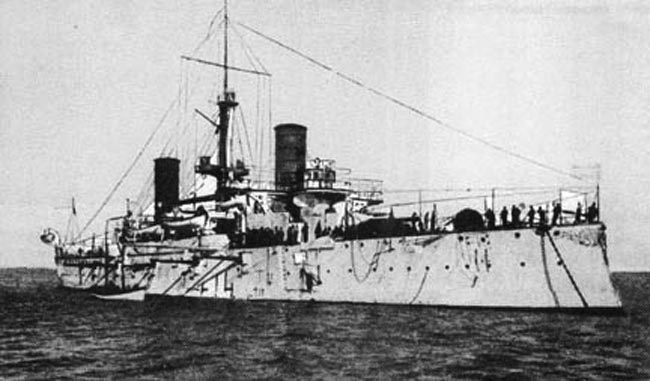
ARA Belgrano, a Garibaldi class armoured cruiser
By late 1901 tensions between Chile and Argentina led to a state close to war, and Chile knew it’s navy could not answer adequately the recently acquired armoured cruisers Rivadavia and Mariano Moreno ordered from Italy in the excellent Garibaldi class (ten built, exported also to Japan and Spain), armed with a single 10-in an a 8-in, like the ARA General Belgrano (launched 1896) and Pueyrredón (launched 1898). With the next two Rivadavia and Moreno, they would have four of them.
However it happened at the time that Sir Edward Reed (the chief designer for Armstrong Whitworth) was pecisely in vacations in the mountains of Chile for his health, and learning about it, met with Chilean Navy officials to discuss a purchase or a new construction of fast capital ships to deal with the issue. He soon studied existing options and they were ruled out, so the staff hasked him to come with a purpose-designed solution. It was a combination of high speed, powerful armament and low displacement.
The Chileans were smithed by his ideas and asked Reed to make a fully fledged design intended for construction, and soon after Chile ordered both ships in emergency. They were to be named Constitución and Libertad. In 1901, while Reed was back in Great Britain, “Constitución” was laid down in from Armstrong Whitworth, Elswick and “Libertad” in Vickers at Barrow-in-Furness.
As drafted, as also according to British ow ratings, they were considered second-class battleships: Construction and armamement as well as armour were all light, everything was sacrificed to speed, tailored to catch armored cruisers: The Garibaldi class however were capable of 20 kts. Chile also required their hulls to fit inside their graving dock at Talcahuano, forcing Reed to make them narrower, and thus longer to keep buoyancy, way more than British standards. Many details were tailored for Chile, such as their masts, anchor arrangements, magazines, or shell-handling rooms.
Tension decrease and requisition
The Pacts of May were four protocols signed in Santiago de Chile, between Chile and Argentina on 28 May 1902. Politicians prevailed over their respective taxpayer’s interests. One one stroke of a pen, they ended ended the feverish atmosphere between the countries. Soon without object, Argentina’s latest orders were cancelled: Rivadavia and Moreno under construction, were resold to Japan.
On their side, the Chilean did the same. Constitución and Libertad thus ended on sale in early 1903, still under construction. At the time, the Royal Navy expressed being not interested by the design, which was too specific and fir no need. However British politicians intervened: A the time, the United Kingdom was itself in a tense relationship with the Russian Empire.
The latter through their ambassador made promptly an offer for both larning where the previous armoured cruisers were repurchased by Japan. The latter since 1902 was a British Ally. So the British authorities to prevent this, forced the hand of the RN and purchased both Chilean vessels on 3 December 1903, for £2,432,000, by Antony Gibbs & Sons of London, financed in a partnership run by Alban and Vicary Gibbs, both members of Parliament. This cost the latter his seat at the House of Commons over an old law about MPs accepting contracts from the Crown. New elections had Alban being re-elected and Vicary out.
The Royal Navy obtained these vessels for cheap, but still, they required modifications during completion to have them standardized. But it was soon partly denield due to cost concerns. Major changes were only partially realized, and both were eventually were completed in June 1904, renamed, Constitución becoming HMS Swiftsure and Libertad HMS Triumph. At that date, they were already obsolescent and as said above, fit no need in the RN. The admiralty had to find one for them.
Design in detail

Brassey’s depiction
Hull construction
The Swiftsure-class’s overall length was 475 feet 3 inches (144.9 m), which was way superior to all pre-dreanoughts at the time (ten meters more than the Lord Nelson class in construction for example). They were also 71 feet 1 inch (21.7 m) wide (Lrd Nelson was 79 feets or 24.2 m) and a draught of just 28 feet 6 inches (8.7 m – there again, 30 feets or 9.1 m) deeply loaded. Displacement was 12,175 long tons (12,370 t) in normal load, 13,840 long tons (14,060 t) deep. There again versus 15,358 and 17,820 ton repectively. Still, they ended 375 long tons overweight compared to their designed displacement. This increased draught dangerously to belt armour concerns, and their freeboard as well, making them “wet” in heavy weather.
For their general appearance, they still resembled superficially standard pre-dreadnoughts of the time, with the same symetry, two heavenly spaced funnel, two bridges an dtwo military masts, a reinforced ram bow, and a central battery with seondaries in casemates. Between the fact they were stretched out and their turrets were smaller in proportions, unlike regular pe-dreadnoughts. In 1914, their crew amounted to 803 between officers and ratings. They were the last British battleships to enter service with bow crests and ventilation cowls.

Blueprint of the class
Powerplant
Both vessels’s propulsion rested on two shafts, driven by four-cylinder inverted vertical triple-expansion (IVTE) steam engines, fed by the steam from twelve Yarrow boilers at a working pressure of 280 psi (1,931 kPa; 20 kgf/cm2). Total output as indicated wa 12,500 indicated horsepower (9,300 kW) for a design speed of 19.5 knots (36.1 km/h; 22.4 mph). On paper it was less than the Garibaldi class though.
Fortunately for the builder and original customers, this machinery arrangement proved more powerful than anticipated: They reached indeed 20 knots (37 km/h; 23 mph) in sea trials, thus making them the fastest battleships in the Royal Navy at the time. Sustained speed in service however was slightly slower than the Duncan class. For range, they carried 2,048 long tons (2,081 t) of coal which was enough for 6,210 nautical miles (11,500 km; 7,150 mi) at 10 knots, this was sufficient for south american waters, but barely enough compared to the Lord Nelson class for example (9180 nmi@ 10 knots).
In service they proved however also more economical than estimated, and could reach 12,000 nautical miles (22,000 km; 14,000 mi) in fact at 10 knots in “wartime loading” – with coal filling all possible voids aboard. So she was the fastest and longest-range in the RN. What also satisfied the admiralty was their responsivity at the helm: They proved quite manoeuvrable due to their large balanced rudder and refined hull form optimized to make it more effective and capitalyze on her “narrow waist”. By some measure, she almost could be compared to what would resemble a battlecruiser at the pre-dreadnought age.
Armament
Composition was relatively standard at the time for pre-dreadnoughts, but with lighter main guns, and the same heavy secondary battery like the Lord Nelson class with nearly 8-in guns.
Main: 2×2 Vickers 10-in/45 Mk VI/VII (254 mm)
Being a tailored Chilean design, the Swiftsure class happened to be the first British battleships since 1895 HMS Renown to mount a main battery of 10-inch (254 mm) guns, and last to do so. These were the reason they were considered “2nd class”, although these guns were far more modern and combined with the QF heavy secondary battety still made for a powerful combination. They would cetainly have caused immense problems to Garibaldi class vessels.
These 45-calibre 10-inch guns were tailor-designed also by the builder (Mk VI on Switfsure, MkVII on Triumph) following standard British practice with a placement in two twin turrets forward and aft. The RN evaluated they would defeat the armour of the latest German and Russian battleships but not French ones, but certainly defeat the Italian cruisers, which sported a 150 mm (5.9 in) thick belt in the central section of the citadel.
- 500-pound (227 kg) shell
- Muzzle velocity 2,656 ft/s (810 m/s)
- Maximum range 14,800 yards (13,500 m)
- Maximum elevation 13.5°
- Rate of fire 1.5 rpm Mk.VI, 2–2.5 rpm Mk.VII
- 90 rounds per gun
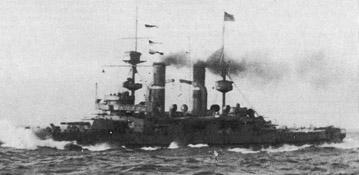
Secondary: 14x 7.5 in/50 (191mm)
This was certainly the main asset of this design. No british Battleship ever had such powerful secondary weaponry, even the Lord Nelson class which had a battery of ten of these, but in turrets, making them superior to casemates. They compared well to the fourteen 6-in guns of the italian designs.
These 50-calibre 7.5-inch guns were different also from thos mounted on later British cruisers. They were mounted in a central battery on the main deck, and criticized for taking up too much deck space and as being too wet, since they were just about 10 feet (3 m) above water, deeply loaded, and as we said before, the ship were lower as expected due to be overweight. In fact, they were unusable in heavy weather, which was uncommon in the southern Atlantic or Pacific on that matter.
The last four were located in casemates abreast the fore and main masts, upper deck and thus, proof agains this heavy weather issue. But the casemated guns issue was considerable as the Britihsh admiraly found, whe the ship rolled more than 14°, their muzzle seeped water in ! That’s a reason why they were soon sent in tropical, distant station. Nobody wanted them in the north sea by all account. They differed slightly in design again but has the same performance. Their range was almost the same as the main guns, and they were two to three times faster.
- 200-pound (91 kg) HE shell
- Muzzle velocity 2,781 ft/s (848 m/s)
- Rate of fire: 4 rounds per minute
- Maximum elevation 15°
- Maximum range 14,000 yards (13,000 m)
- 150 rounds per gun
Tertiary: 14x 14 pdr + 4x 6pdr and TTs
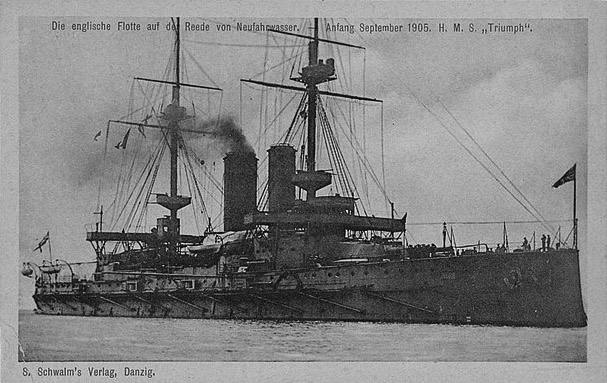
German postcard – HMS Triumph
The anti-torpedo boat armament was mixed, comprising fourteen 14-pdr QF/3-inch (76 mm) quick-firing Mk I or Mk II guns (depending of the ships), modified to be compattble with QF 12 pounder 18 cwt ammunitions. They were located in hull embrasures (recesses) fore and aft for four of them, two in the upper battery deck between the upper casemates and under masks in open air, two in the bridge forward, two on the aft bridge, and the remainder four on the roofs of the upper casemates.
- Designed for firing 14-pound (6.4 kg) shells
- Modified to use the standard 12.5-pound (5.7 kg) shell
- Muzzle Velocity (est.) 2,500 ft/s (777 m/s)
- Rate of fire (est.) 10 rpm
- 200 round per gun
- Range (est. model 1909) 10,930 yards (10,000 m) at 20°
The second tertiary battery comprised, faster firing 2.2 inches or QF 6 pdr Hotchkiss guns, located in part on the upper deck roofs, and in the upper platform over the bridge, plus the two military tops. They were standard models, well widespread in the RN and firing 57x307R 57-millimetre (2.244 in) shells. Theese guns used a vertical sliding-block and Hydro-spring 4 inch recouil mechanism, for a 25 rpm rate at 1,818 feet per second (554 m/s) up to 4,000 yards (3,700 m) with HE shells. Funnily enough, their also equipped their initial opponents, the ARA General Belgrano and other cruisers of the same class.
TTs: 2 single 18-in (450 mm)
This pair of 17.7 in (450 mm) submerged torpedo tubes were located each broadside and provided with nine torpedoes. Likely these were the Mark VI, capable of 28.5 knots (52.8 km/h; 32.8 mph) at 4,000 yd (3,700 m) or a 41 knots setting (76 km/h; 47 mph) at 1,000 yd (910 m), propelled by Compressed air and carrying a 296 lb (134 kg) including pistol warhead, same as the 1899 Mark V.
Fire control Systems
Details for this are fairly sparse, since their 10-in main battery was rare, and the FCS were omitted from Handbook for Fire Control Instruments published in 1914. We can assumed them loosely close to those of the Duncan class. However in September 1914, it was reported they were allowed four additional pairs of Pattern 343 Service Binoculars. It seems they never received firectors for the main or secondaries, or Dreyer tables. They were poorly accurate ships presumably but still hold their own agains forts in the Dardanelles, which is at least that.
Armour scheme
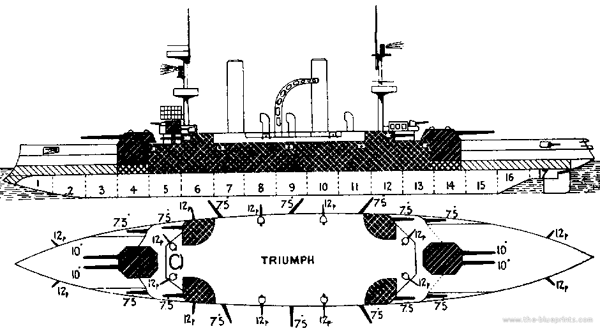
1906 Jane’s plan
The Swiftsure class has a classic scheme, based on the Duncan class, but with slitghly lower figures, using Krupp cemented armour (KCA) for the most sensitive parts as requested by the Chileans. Overall, as stated by Naval historian R. A. Burt, the reduction in thickness of their barbette armour below the upper deck was considerably improving her chances to survive a penetrating 10-in shell, but he still through that this made the the magazines vulnerable to lucky oblique hits near the barbettes.
- Waterline main belt: 7 inches (178 mm) over 8 ft (2.4 m) high, 5 ft 3 in (1.6 m) bw
- Fore and aft transverse bulkheads 2–6-inch (51–152 mm)
- Fore and aft belt 6 in abreast barbettes, 2 inches aft of barbettes
- 3 in (76 mm) transverse bulkhead after barbette
- Upper strake 7-inch oblique belt armour to upper deck.
- Upper deck casemates 7-inch faces and sides, rear 3 in plates
- 7.5-inch guns main deck 1 in (25 mm) screens
- 0.5 in plating on funnel uptakes
- Longitudinal 1 in bulkhead in the battery’s centreline to stop crossing shrapnel
- Turret faces 9 in (229 mm), side, rear 8 in (203 mm) roofs 2 in, sighting hoods 1.5 in
- Barbettes 10 in (254 mm) outward, 8 in internal sides
- Barbette below citadel 3-2 in
- conning tower 11-in (279 mm) face, 8-in rear
- Deck armour, inside central citadel 1-1.5 in
- Lower deck 3-in sloped to meet the lower belt armour
Construction & General Assessment
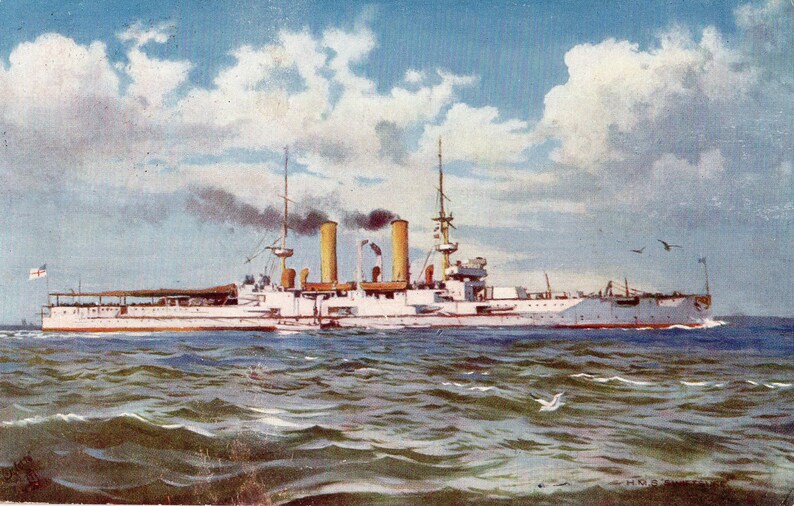
HMS Swiftsure was laid down as Constitución at Armstrong Whitworth, Elswick on 26 February 1902. She was launched on 12 January 1903, well after her repurchase, and completed in June 1904, at a cost, exclusing armament, of £846,596. HMS Triumph, (former Libertad) was laid down at Vickers, Sons & Maxim, Barrow-in-Furness, on 26 February 1902, launche on 15 January 1903 and completed also in June 1904 at a cost, also without armament, of £847,520. She was actually a tiny bit costier.
As said above, both vessels were initially intended to deal with Garibaldi class cruisers, and they certainly fulfilled their mission, having four 10-in guns against one, a way heavier secondary armament which outranged the latter’s 6-in (152 mm) guns, were way better protected, and just as fast as shown on trials. They would certainly had forced the Argentines to ramp up thei games as the race would go on past 1904. As we all know, they did, ordered the “new” Rivadavia battleships to counter, this time, the Brazilians Dreadnoughts. Chile answered a bit late owing budgetary constrains.
In British service, the admiraty at first scratched its head thinking about how to deal with these unwanted odd vessels. They were reconditioned to British needs, and turned out to be a little better than expected on some points, like speed, range and agility, but suffered both from a heavier construction making them “wet” overall, even to forbid any use of their powerful secondary battery. Thus, unable to fit in the Britush Grand Fleet opposed to the Hochseeflotte, like most pre-dreadnoughts they were sidelined in secondary theaters, colonial outposts of the Empire, but not before seeing four years of Channel Fleet until 1908. Water were a bit calmer there.
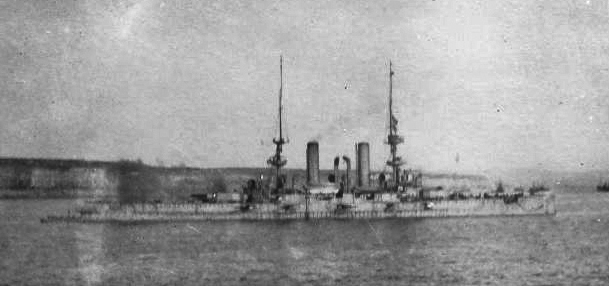
HMS Swiftsure in action
Swiftsure after her collision and repairs, double by a full overhaul, was sent to the Mediterranean Fleet and served there intensively during WWI, also participating in the dardanelles Operations, including shelling forts, although her weaker armour than battleships made her more vulnerable. She was back in the Atlantic in February 1916 and by 1917 placed in reserv to free her precious crew for more modern vessels, so clearly no longer wanted first line. Decision was also motivated by the loss of her sister on the Mediterranean: Her old ASW protection was not equal to the danger of rampaging u-Boats in the Atlantic, making her improper to escort duties.
Triumph decidedly was as unlucky as her sister, damaged also in collision and repaired, and she had a more “colorful” career, in the Mediterranean Fleet like her sister from 26 April 1909, Home Fleet, China Station, decomm; there until the war broke out, and hunting down German ships and assets in China before being back to take her tout of duty in the 1915’s Dardanelles Campaign. Her sinking off Gaba Tepe by U-21 was another reminder pre-dreadnoughts were no proof against either mines of submarines, pompting admiral De Robeck to remove them from frontline.
The sinking was a “lucky attack” since she moved slowly when firing, with her torpedo nets out and most watertight doors shut. But it happened that the unique torpeo somewhat managed to cut through her starboard torpedo net before hitting her underbelly. Without comprehensive compartimentation or thick underwater longitudinal bulkheads, even sufficient engine compartimentation, flooding was quick. She took 30° in a mere five minutes and capzied after ten. It happened after a massive explosion which tore out her flanks. It seems indeed, the torpedo hit near an ammunition magazine. However she had enough buoyancy to remain afloat for 30 minutes, enough for most of her crew to survive.
At the end, both vessels never really showed a particularly valuable potential for the Royal Navy except for hunting down armored cruisers, which was their main affectation once they were sent to the Mediterranean. Unwanted at first, they never found their place in the RN, and were not an overly successful design, also showing frequent change of assignations during their career and early retirement of the surviving Swiftsure in 1917.
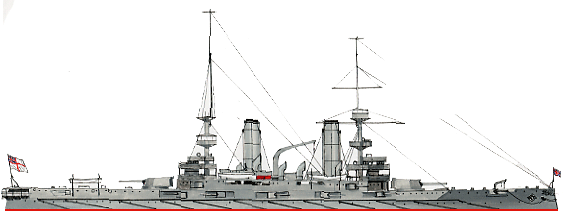
Author’s illu of the Swiftsure class in 1914
⚙ Swiftsure class specifications |
|
| Dimensions | 144,9 x 21,7 x 8,3 m (475 x 71 x 24 ft) |
| Displacement | 12,175t – 13,840t FL |
| Crew | 803 in 1914 |
| Propulsion | 2 shaft TE, 12 Yarrow boilers, 12.500 hp |
| Speed | 19 knots top speed (35 kph; 22 mph) |
| Range | 6,210 nm (11,500 km, 7,150 mi)@ 10 knots |
| Armament | 2×2 10-in, 14x 7.5 in, 14 x 3-in, 4x 6pdr, 2x 18in TTs |
Read More/Src

Additional photos, large yard model
Conway’s all the world’s fighting ships 1860-1905 on archive.org
On historyofwar.org
On battleships-cruisers.co.uk
On worldwar1.co.uk
On navypedia.org
The Chilean Navy in 1914: The old Battleship Capitan Prat and six 1890s cruisers.
On the dreadnoughtproject.org
archive.org with the Grand Fleet 4 april 1915
smithsonianmag.com explosiring gallipoli’s wrecks
On battleships-cruisers.co.uk
Gardiner, Robert. Conway’s All the World’s Fighting Ships 1860–1905
Burt, R. A. (1988). British Battleships 1889–1904. Annapolis, Maryland: Naval Institute Press.
Corbett, Julian. Naval Operations to the Battle of the Falklands. History of the Great War: Based on Official Documents. Vol. I
Friedman, Norman (2011). Naval Weapons of World War One. Barnsley, South Yorkshire, UK: Seaforth.
Kindy, David (8 October 2021). “Underwater Museum Allows Divers to Explore Shipwrecks From the Battle of Gallipoli”.
Parkes, Oscar (1990). British Battleships (reprint of the 1957 ed.). Naval Institute Press.
“Narrative of the Events in Connection with the Siege, Blockade and Reduction of the Fortress of Tsingtao” (PDF).
“The Allied China Squadron” (PDF). The Naval Review. Vol. 3, no. 2. pp. 312–321.
Craig, F. W. S. (1989) [1977]. British Parliamentary Election Results 1832–1885 (2nd ed.). Chichester
Scheina, Robert (1987). Latin America: A Naval History, 1810–1987. Annapolis, Maryland: Naval Institute Press.
Model kits
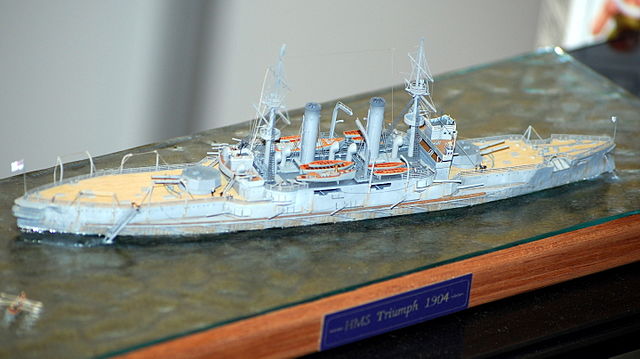
Model kit in a show at Hyeres 2012 (AMW)
Wartime service
 HMS Swiftsure
HMS Swiftsure
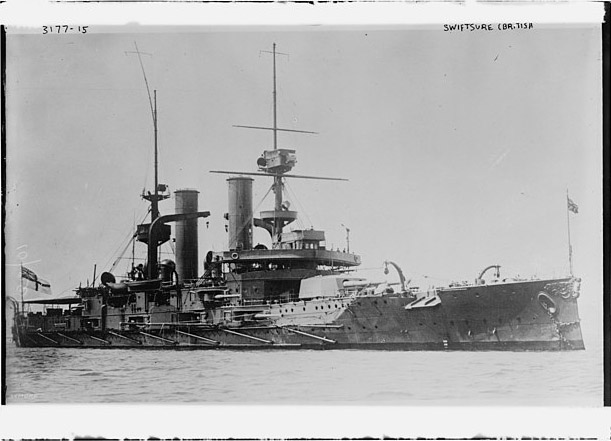
HMS Swiftsure was ordered by Chile as seen above, as “Constitución” but repurchased after cancellation, and after commissioned at Chatham Dockyard (21 June 1904) she was assigned to the Home Fleet. The fleet reorganization of January 1905 saw her in the Channel Fleet. While there, she collided with her sister ship HMS Triumph on 3 June 1905 during manoeuvers at high speed; One propeller was mushed, the sternwalk and aft hull were all abdly difformed and damaged.
She was sent in Chatham Dockyard but repairs only lasted from June to July 1906. After some routine training she was placed in reserve at Portsmouth Dockyard, from 7 October 1908. She exited it on 6 April 1909, fully recommissioned with a new crew and captain, assigned to the Mediterranean Fleet. After routine servive from Gibraltar and some goodwill port visits in 1910, 1911, she was recalled to the Home Fleet on 8 May 1912. At the end of the year, on September 1912 she entered the drydock for a long refit, lasting until March 1913. Recommissioned on 26 March 1913, she was reassigned to the East Indies Station, as flagship.
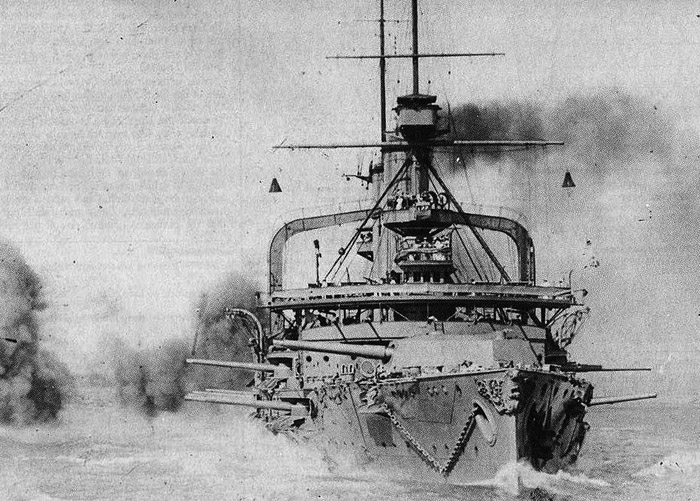
Gunnery practice in 1913
When WWI broke out, HMS Swiftsure was escorting Indian troop convoys from Bombay to Aden. This went on until November 1914, when all urgent troopships were reaffected to the French front; After learning of the skining of the German light cruiser SMS Emden, raiding in the Indian Ocean, the battleship was transferred to the Suez Canal, for a Patrolling routine from 1st December. The Ottoman Turks were pressing on the Canal, Empire’s vital artery. While doing so, she was still attached as flagship to the East Indies Station. On 27 January-4 February 1915 shehelped to defend the Canal, shelling Turkish positions notably near Kantara, which proved instrumental during the First Suez Offensive.
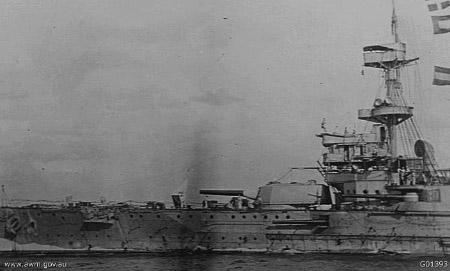
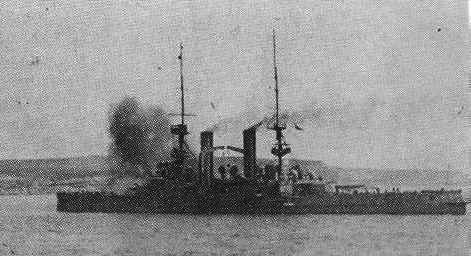
In the Dardanelles, 1915
Relieved, logically, from her East Indies Station duties, by HMS Euryalus in February 1915, she was reassigned to the to the Dardanelles fleet. There, she was fully involved in the Campaign. Starting operations with the Squadron on 28 February 1915 she bombarded Fort Dardanos, from 2 March 1915. Soon joined by her sister-ship HMS Triumph from 5 March 1915, she started shelling fortifications at Smyrna. She was back in the Dardanelles on 9 March 1915.
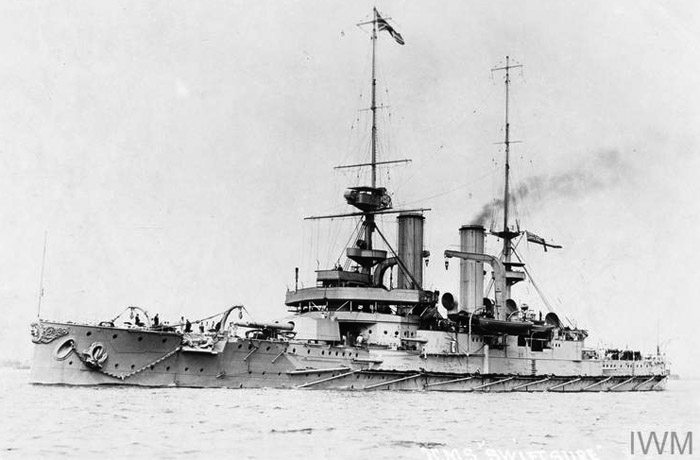
Both battleships took part in the main attack on the Narrows forts, on 18 March 1915. They also supported the main landings at West Beach, Cape Helles (25 April) and all other landings afterwards, notably covering Achi Baba on 4 June. On 18 September she was ambushed while underway from Mudros to Suvla Bay by a German U-Boat. The latter fired, but missed. Her lookouts spotted the trails and gave alarm, after which she dodged them rudder hard over. She later bombared Dedeagatch, on 18 January 1916.
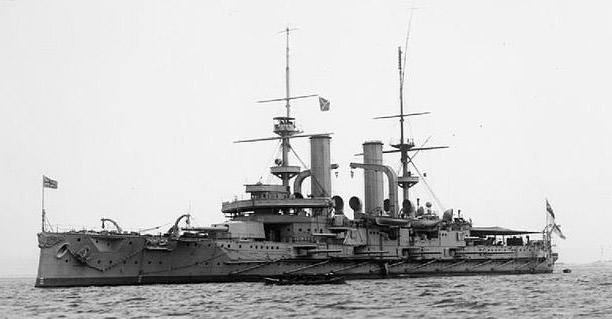
However at this point, piercing the Dardanelles gap has been too costly for the allies, and the squadron retired, including HMS Swiftsure, in February 1916. She sailed from Kephale on the 7th and stamed west to Gibraltar, stopping to Malta en route. There, she was attached to the 9th Cruiser Squadron, and pressed inti the Atlantic Patrol, providing convoy escort.
She was later transferred, from the 9th Cruiser Squadron (March 1917) at Sierra Leone, departing again on 26 March for home, Plymouth (11 April). Due to her age and type, the admiralty decided to free her crew for more modern ASW vessels just about to be commissioned, and she was was paid off at Chatham (26th). Into reserve she was refitted just for maintenance and being given depot ships accomodations at Chatham, by mid-1917. She was stationed there as such from February 1918. The autumn saw her stripped from all her armament. She was reassigned as a blockship, proposed to block for good the Zeebruge canal, for a planned second attempt to blockade Ostend. The war ended and the plan dropped. Instead, she was briefly used as target ship. Then she was stricken and listed for sale from March 1920. On 18 June, she went to Stanlee Shipbreaking Company and was BU.
 HMS Triumph
HMS Triumph
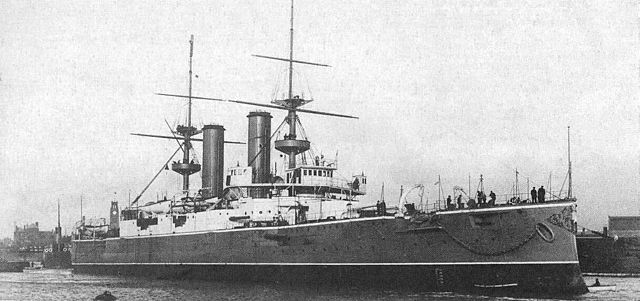
HMS Triumph completed in January 1904, note her peacetime livery, soon replaced by medium grey.
HMS Triumph was ordered by Chile as Libertad but completed, commissioned as HMS Triumph at Chatham, on 21 June 1904, assigned first to the Home Fleet. On 17 September 1904 she collided with SS Siren off Pembroke but damage was light. From January 1905, she was in the Channel Fleet and collided again, this time with her sister ship HMS Swiftsure on 3 June 1905. The latter impaled on her bow, that she had to be repaired at Chatham in October 1908. Like her sister she was sent to the Mediterranean Fleet, arriving in Gibraltar on 26 April 1909. After uneventful service, she was sent to the Home Fleet in May 1912, and transferred to the China Station on 28 August 1913. While in Hong Kong she was placed in reserved. Inn August 1914 she was remobilized.
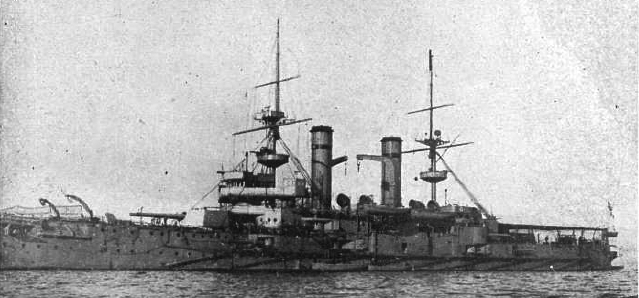
HMS Triumph had now crew and old river gunboats were stripped of theirs, supplemented with two officers and 100 ratins and six signallers from the Duke of Cornwall’s local Light Marine Infantry. She steamed at sea for training on 6 August 1914, but was soon redirected to the Japanese besieged German colony of Tsingtao. Her duty was to stop German shipping and create a blockade. Together with the French cruiser Dupleix, she captured the German merchant ship Senegambia inbound to the colony with food, on the morning of 21 August. Dupleix later captured a second merchant ship, C. Ferd Laeiz. On the 21 August in the evening, Triumph captured the stemaer Frisia carrying coal and cattle.
On 23 August 1914, she was attached to the Imperial Japanese Navy’s Second Fleet, landed a volunteer’s infantry party at Wei-hai-wei, and returned to the siege of Tsingtao. In September 1914 with the destroyer HMS Usk, she escorted a British troopship convoy to be landed at Tsingtao, also bombarding German positions until the Japanese overruned the defenders and captured the colony. HMS Triumph was hit by a German shell on 14 October, damaging her mainmast, and killing one, wounding two. She returned to Hong Kong for a refit (started 19 November).
By January 1915, she was reassigned to the Dardanelles operation and departed Hong Kong on the 12th, stopped at Suez (7-12 February) and arrived in the Dardanelles, taking part in the opening attack on the entrance forts (18-19th) with HMS Albion and Cornwallis. Her secondary battery turned to rubble the fort at Sedd el Bahr on 25 February. With Albion and Majestic she entered the Turkish Straits and bombed inner from the 26th, and was assigned the attack on Fort Dardanos (2 March 1915). Joined by HMS Swiftsure from 5 March she was sent to Smyrna, and returning to the Dardanelles on the 9th.
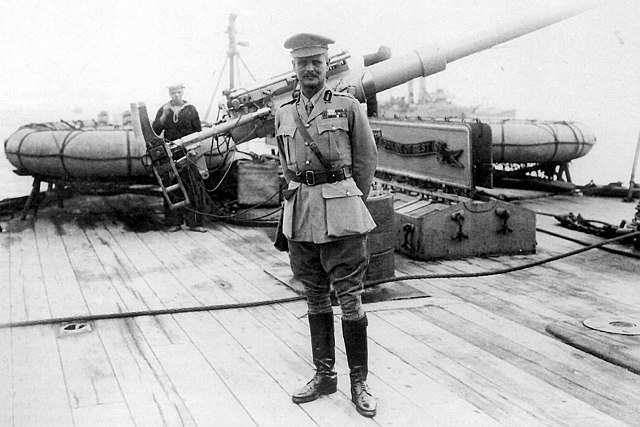
Col. William Birdwood on HMS swiftsure
Next she shelled on 15-18 April the Narrows forts but during the night, one of her picket boats, plus and one from Majestic’s, armed with torpedoes mounted in dropping gear tried to sink the stranded submarine E15 beneath Fort Dardanos, that the German and Ottoman forces were about to capture. This was a success. Later HMS Triumph covered the Anzacs at Gaba Tepe on the 25th, with continuous artillery support in May.
On the 25th she was underway off Gaba Tepe, with her torpedo nets out when sighted at 400 yards (370 m) by U-21 (Lieutenant Otto Hersing) off her starboard beam. It was 12:30 PM. HMS Triumph’s spotted the periscope and all light guns opened fire but it was already too late as a torpedo had een launched, which passed through her torpedo net and struck the hull starboard.
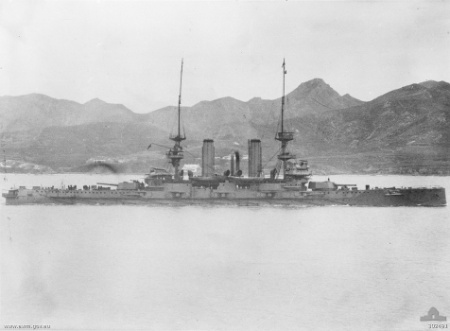
HMS Triumph off Gallipoli, 1915 (AWM)
A massive explosion rocked Triumph, probably because it hit an ammo magazine. The gash opened let water pour in, and she rapidly took a 10° starboard list, but other compartment held eneough for about five minutes, she did not capsized; However after some inner walls or hatches gaves way due to the pressure, the floosing resumed and she took 30°. HMS Chelmer, a destroyer, came alongside to evacuate all the men she could, before she capsized ten minutes later. Her belly was still afloat for around 30 minutes until she sank for good, resting under 180 feet (55 m) and carrying to the bottom three officers and 75 ratings. She was struck from the list back home.
In October 2021, Turkey opened the underwater Gallipoli Historic Park off Canakkale for scuba divers, including several wrecks, now war graves, from the Dardanelles and Gallipoli campaigns, including Triumph and Majestic.
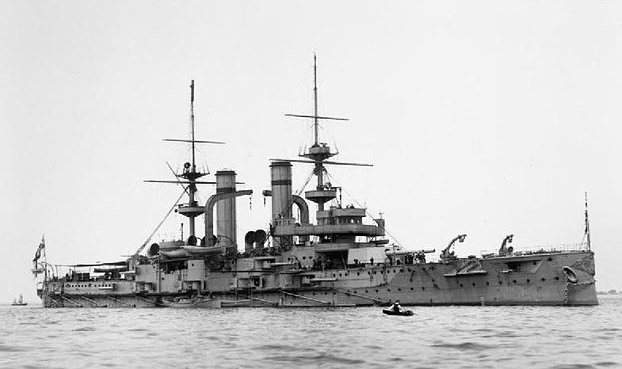
HMS Triumph IWM Q40369


 Latest Facebook Entry -
Latest Facebook Entry -  X(Tweeter) Naval Encyclopedia's deck archive
X(Tweeter) Naval Encyclopedia's deck archive Instagram (@navalencyc)
Instagram (@navalencyc)





 French Navy
French Navy Royal Navy
Royal Navy Russian Navy
Russian Navy Armada Espanola
Armada Espanola Austrian Navy
Austrian Navy K.u.K. Kriegsmarine
K.u.K. Kriegsmarine Dansk Marine
Dansk Marine Nautiko Hellenon
Nautiko Hellenon Koninklije Marine 1870
Koninklije Marine 1870 Marinha do Brasil
Marinha do Brasil Osmanlı Donanması
Osmanlı Donanması Marina Do Peru
Marina Do Peru Marinha do Portugal
Marinha do Portugal Regia Marina 1870
Regia Marina 1870 Nihhon Kaigun 1870
Nihhon Kaigun 1870 Preußische Marine 1870
Preußische Marine 1870 Russkiy Flot 1870
Russkiy Flot 1870 Svenska marinen
Svenska marinen Søværnet
Søværnet Union Navy
Union Navy Confederate Navy
Confederate Navy Armada de Argentina
Armada de Argentina Imperial Chinese Navy
Imperial Chinese Navy Marinha do Portugal
Marinha do Portugal Mexico
Mexico Kaiserliche Marine
Kaiserliche Marine 1898 US Navy
1898 US Navy Sovietskiy Flot
Sovietskiy Flot Royal Canadian Navy
Royal Canadian Navy Royal Australian Navy
Royal Australian Navy RNZN Fleet
RNZN Fleet Chinese Navy 1937
Chinese Navy 1937 Kriegsmarine
Kriegsmarine Chilean Navy
Chilean Navy Danish Navy
Danish Navy Finnish Navy
Finnish Navy Hellenic Navy
Hellenic Navy Polish Navy
Polish Navy Romanian Navy
Romanian Navy Turkish Navy
Turkish Navy Royal Yugoslav Navy
Royal Yugoslav Navy Royal Thai Navy
Royal Thai Navy Minor Navies
Minor Navies Albania
Albania Austria
Austria Belgium
Belgium Columbia
Columbia Costa Rica
Costa Rica Cuba
Cuba Czechoslovakia
Czechoslovakia Dominican Republic
Dominican Republic Haiti
Haiti Hungary
Hungary Honduras
Honduras Estonia
Estonia Iceland
Iceland Eire
Eire Equador
Equador Iran
Iran Iraq
Iraq Latvia
Latvia Liberia
Liberia Lithuania
Lithuania Mandchukuo
Mandchukuo Morocco
Morocco Nicaragua
Nicaragua Persia
Persia San Salvador
San Salvador Sarawak
Sarawak Uruguay
Uruguay Venezuela
Venezuela Zanzibar
Zanzibar Warsaw Pact Navies
Warsaw Pact Navies Bulgaria
Bulgaria Hungary
Hungary

 Bundesmarine
Bundesmarine Dutch Navy
Dutch Navy Hellenic Navy
Hellenic Navy Marina Militare
Marina Militare Yugoslav Navy
Yugoslav Navy Chinese Navy
Chinese Navy Indian Navy
Indian Navy Indonesian Navy
Indonesian Navy JMSDF
JMSDF North Korean Navy
North Korean Navy Pakistani Navy
Pakistani Navy Philippines Navy
Philippines Navy ROKN
ROKN Rep. of Singapore Navy
Rep. of Singapore Navy Taiwanese Navy
Taiwanese Navy IDF Navy
IDF Navy Saudi Navy
Saudi Navy Royal New Zealand Navy
Royal New Zealand Navy Egyptian Navy
Egyptian Navy South African Navy
South African Navy






























 Ukrainian Navy
Ukrainian Navy dbodesign
dbodesign